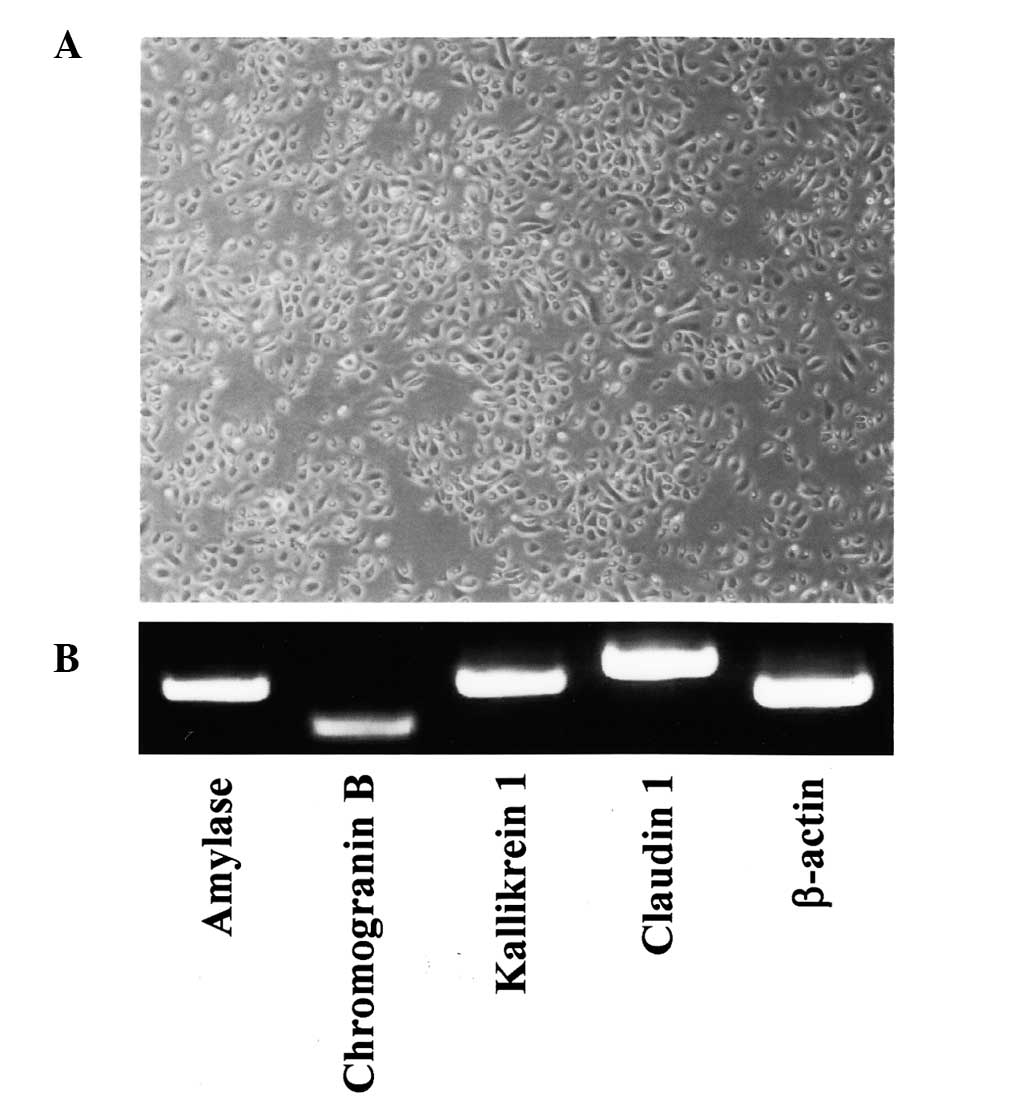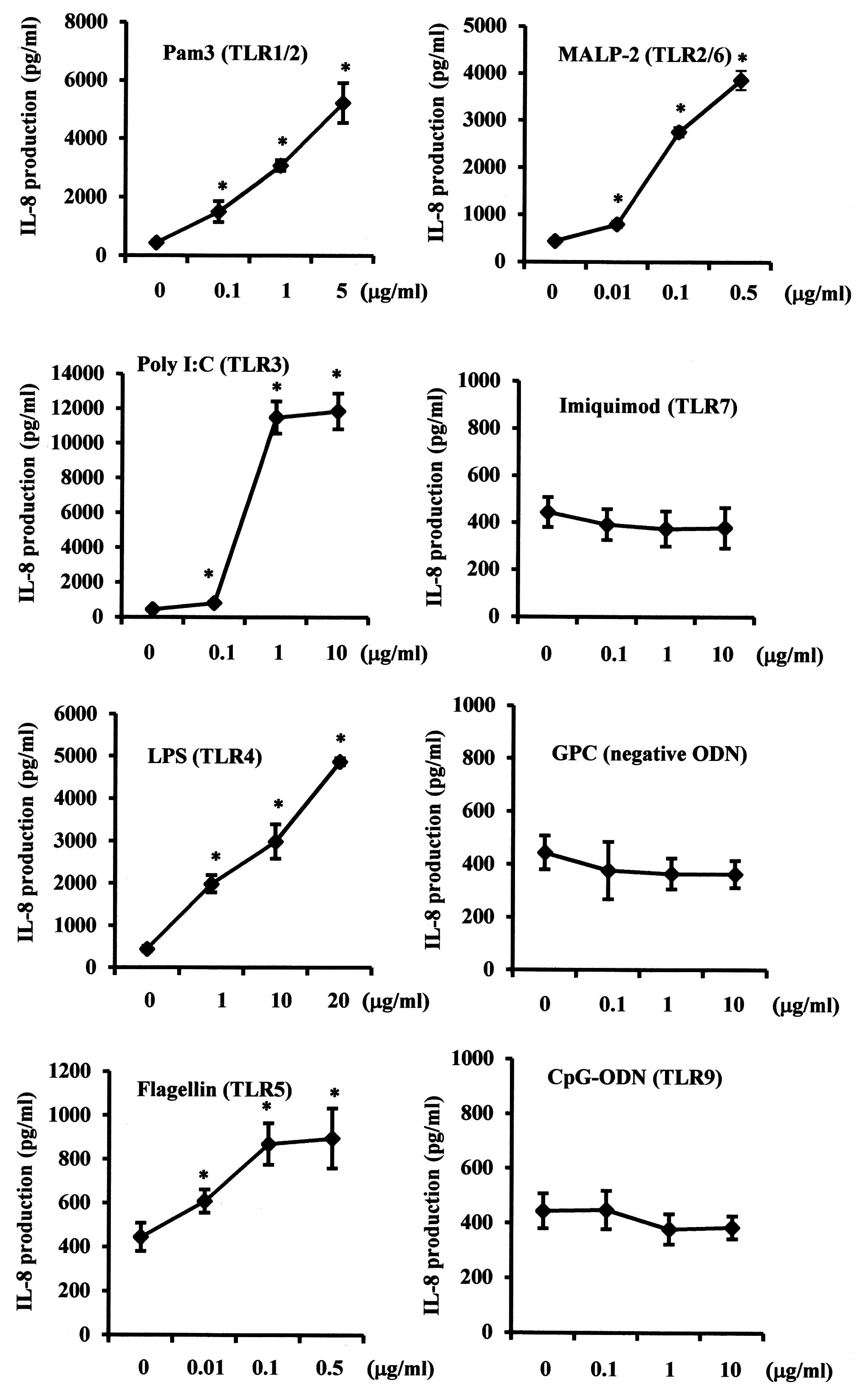|
1
|
Takeda K, Kaisho T and Akira S: Toll-like
receptors. Annu Rev Immunol. 21:335–376. 2003. View Article : Google Scholar
|
|
2
|
Midwood KS, Piccinini AM and Sacre S:
Targeting Toll-like receptors in autoimmunity. Curr Drug Targets.
10:1139–1155. 2009. View Article : Google Scholar : PubMed/NCBI
|
|
3
|
Kumar H, Kawai T and Akira S: Toll-like
receptors and innate immunity. Biochem Biophys Res Commun.
388:621–625. 2009. View Article : Google Scholar : PubMed/NCBI
|
|
4
|
Han DC, Huang GT, Lin LM, et al:
Expression of MHC Class II, CD70, CD80, CD86 and pro-inflammatory
cytokines is differentially regulated in oral epithelial cells
following bacterial challenge. Oral Microbiol Immunol. 18:350–358.
2003. View Article : Google Scholar
|
|
5
|
Kawai T, Takeuchi O, Fujita T, et al:
Lipopolysaccharide stimulates the MyD88-independent pathway and
results in activation of IFN-regulatory factor 3 and the expression
of a subset of lipopolysaccharide-inducible genes. J Immunol.
167:5887–5894. 2001. View Article : Google Scholar
|
|
6
|
Anders HJ, Vielhauer V, Eis V, et al:
Activation of toll-like receptor-9 induces progression of renal
disease in MRL-Fas (lpr) mice. FASEB J. 18:534–536. 2004.PubMed/NCBI
|
|
7
|
Kobayashi Y, Murakami H, Akbar SM, Matsui
H and Onji M: A novel and effective approach of developing
aggressive experimental autoimmune gastritis in neonatal
thymectomized BALB/c mouse by polyinosinic:polycytidylic acid. Clin
Exp Immunol. 136:423–431. 2004. View Article : Google Scholar
|
|
8
|
Qu WM, Miyazaki T, Terada M, et al: A
novel autoimmune pancreatitis model in MRL mice treated with
polyinosinic:polycytidylic acid. Clin Exp Immunol. 129:27–34. 2002.
View Article : Google Scholar : PubMed/NCBI
|
|
9
|
Birchler T, Seibl R, Büchner K, et al:
Human Toll-like receptor 2 mediates induction of the antimicrobial
peptide human beta-defensin 2 in response to bacterial lipoprotein.
Eur J Immunol. 31:3131–3137. 2001. View Article : Google Scholar : PubMed/NCBI
|
|
10
|
Böcker U, Yezerskyy O, Feick P, et al:
Responsiveness of intestinal epithelial cell lines to
lipopolysaccharide is correlated with Toll-like receptor 4 but not
Toll-like receptor 2 or CD14 expression. Int J Colorectal Dis.
18:25–32. 2003.
|
|
11
|
Hertz CJ, Wu Q, Porter EM, et al:
Activation of Toll-like receptor 2 on human tracheobronchial
epithelial cells induces the antimicrobial peptide human beta
defensin-2. J Immunol. 171:6820–6826. 2003. View Article : Google Scholar : PubMed/NCBI
|
|
12
|
Spachidou MP, Bourazopoulou E, Maratheftis
CI, et al: Expression of functional Toll-like receptors by salivary
gland epithelial cells: increased mRNA expression in cells derived
from patients with primary Sjögren’s syndrome. Clin Exp Immunol.
147:497–503. 2007.PubMed/NCBI
|
|
13
|
Shimizu S, Kurashige Y, Nishimura M, et
al: Involvement of toll-like receptors in autoimmune sialoadenitis
of the non-obese diabetic mouse. J Oral Pathol Med. 41:517–523.
2012.PubMed/NCBI
|
|
14
|
Roescher N, Tak PP and Illei GG: Cytokines
in Sjögren’s syndrome. Oral Dis. 15:519–526. 2009.
|
|
15
|
Fox RI, Kang HI, Ando D, Abrams J and Pisa
E: Cytokine mRNA expression in salivary gland biopsies of Sjögren’s
syndrome. J Immunol. 152:5532–5539. 1994.
|
|
16
|
Cuello C, Palladinetti P, Tedla N, et al:
Chemokine expression and leucocyte infiltration in Sjögren’s
syndrome. Br J Rheumatol. 37:779–783. 1998.
|
|
17
|
Pflugfelder SC, Jones D, Ji Z, Afonso A
and Monroy D: Altered cytokine balance in the tear fluid and
conjunctiva of patients with Sjögren’s syndrome
keratoconjunctivitis sicca. Curr Eye Res. 19:201–211.
1999.PubMed/NCBI
|
|
18
|
Ohta K, Shigeishi H, Taki M, et al:
Regulation of CXCL9/10/11 in human oral keratinocytes and
fibroblasts. J Dent Res. 87:1160–1165. 2008. View Article : Google Scholar
|
|
19
|
Dimitriou ID, Kapsogeorgou EK, Abu-Helu
RF, Moutsopoulos HM and Manoussakis MN: Establishment of a
convenient system for the long-term culture and study of
non-neoplastic human salivary gland epithelial cells. Eur J Oral
Sci. 110:21–30. 2002. View Article : Google Scholar
|
|
20
|
Szlávik V, Szabó B, Vicsek T, et al:
Differentiation of primary human submandibular gland cells cultured
on basement membrane extract. Tissue Eng Part A. 14:1915–1926.
2008.PubMed/NCBI
|
|
21
|
Nishimura M and Naito S: Tissue-specific
mRNA expression profiles of human toll-like receptors and related
genes. Biol Pharm Bull. 28:886–892. 2005. View Article : Google Scholar : PubMed/NCBI
|
|
22
|
Zarember KA and Godowski PJ: Tissue
expression of human Toll-like receptors and differential regulation
of Toll-like receptor mRNAs in leukocytes in response to microbes,
their products, and cytokines. J Immunol. 168:554–561. 2002.
View Article : Google Scholar : PubMed/NCBI
|
|
23
|
Park JH, Yoon HE, Kim DJ, et al: Toll-like
receptor 5 activation promotes migration and invasion of salivary
gland adenocarcinoma. J Oral Pathol Med. 40:187–193. 2011.
View Article : Google Scholar : PubMed/NCBI
|
|
24
|
Ittah M, Miceli-Richard C, Gottenberg JE,
et al: Viruses induce high expression of BAFF by salivary gland
epithelial cells through TLR- and type-I IFN-dependent and
-independent pathways. Eur J Immunol. 38:1058–1064. 2008.
View Article : Google Scholar : PubMed/NCBI
|
|
25
|
Zheng L, Zhang Z, Yu C and Yang C:
Expression of Toll-like receptors 7, 8, and 9 in primary Sjögren’s
syndrome. Oral Surg Oral Med Oral Pathol Oral Radiol Endod.
109:844–850. 2010.PubMed/NCBI
|
|
26
|
Kawakami A, Nakashima K, Tamai M, et al:
Toll-like receptor in salivary glands from patients with Sjögren’s
syndrome: functional analysis by human salivary gland cell line. J
Rheumatol. 34:1019–1026. 2007.
|
|
27
|
Deshmukh US, Nandula SR, Thimmalapura PR,
Scindia YM and Bagavant H: Activation of innate immune responses
through Toll-like receptor 3 causes a rapid loss of salivary gland
function. J Oral Pathol Med. 38:42–47. 2009. View Article : Google Scholar
|
|
28
|
Matsumura R, Umemiya K, Goto T, et al:
Interferon gamma and tumor necrosis factor alpha induce Fas
expression and anti-Fas mediated apoptosis in a salivary ductal
cell line. Clin Exp Rheumatol. 18:311–318. 2000.PubMed/NCBI
|
|
29
|
Hajnická V, Kocáková P, Sláviková M, et
al: Anti-interleukin-8 activity of tick salivary gland extracts.
Parasite Immunol. 23:483–489. 2001.PubMed/NCBI
|
|
30
|
Akira S and Takeda K: Toll-like receptor
signalling. Nat Rev Immunol. 4:499–511. 2004. View Article : Google Scholar
|
|
31
|
Ittah M, Miceli-Richard C, Gottenberg JE,
et al: B-cell-activating factor expressions in salivary epithelial
cells after dsRNA virus infection depends on RNA-activated protein
kinase activation. Eur J Immunol. 39:1271–1279. 2009. View Article : Google Scholar
|
|
32
|
Lisi S, Sisto M, Lofrumento DD and D’Amore
M: Sjögren’s syndrome autoantibodies provoke changes in gene
expression profiles of inflammatory cytokines triggering a pathway
involving TACE/NF-κB. Lab Invest. 92:615–624. 2012.
|
|
33
|
Li J, Kartha S, Iasvovskaia S, et al:
Regulation of human airway epithelial cell IL-8 expression by MAP
kinases. Am J Physiol Lung Cell Mol Physiol. 283:L690–L699.
2002.PubMed/NCBI
|













